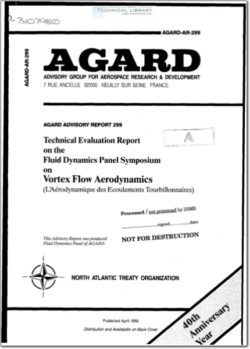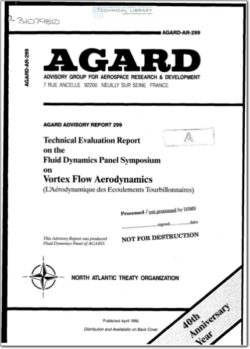AGARD-AR-299

- Version
- 179 Downloads
- 1.85 MB File Size
- 1 File Count
- March 8, 2016 Create Date
- March 8, 2016 Last Updated
Vortex Flow Aerodynamics

The Symposium was held in a hotel in Scheveningen,
the Netherlands, from the fst to the 4th of October 1990.
The Fluid Dynamics Panel arranges two symposia a year,
divided roughly equally between topics close to areas of
application and topics which expose fundamental problems.
This one. on vortex flow aerodynamics, was clearly aimed at
a range of fundamental problems. A strong programme
committee, drawn from the membership of the FOP, was set
up under the leadership of Dr Campbell and Prof Young.
Its members, listed in Appendix A, come from nine AGARD
nations.
The need for the meeting is clearly stated in the call for
papers and the programme.
Separation-induced vortex flows are an important part
of the design and off-design performance of fighter aircraft,
missiles, and space-plane concepts. A better under-
standing is needed in order to predict and control these
vortex flows throughout the flight envelope at subsonic.
transonic, and supersonic speeds, and especially during
high-lift operations for take-offs and landings and sustained
and instantaneous manoeuvres.‘
Alongside the need for a better understanding is the
need for a predictive capability which leads to improved
performance and manoeuvrability, to reduced development
time and cost, and to longer aircraft life. To quote again
from the call for papers.
A wide range of methods are used at present to calcu-
late separation-induced vortex flows. Theory-experimental
(wind-tunnel and flight) comparisons are required to
establish the value of these methods for various flow
regimes so far as basic physics and applications are
concerned. The problem of scaling wind-tunnel results to
flight conditions also deserves specific attention.”
These general considerations led to the identification
of four specific topics which the organizers hoped would be
covered by presentations.
‘Vortex fundamentals, including boundary-layer separ-
ation lines on wing surfaces and edges, vortex development
and burst, vortex cores, sheets, and filaments, vortical flow
interactions with each other and with the flow over neigh-
bouring surfaces, which include multiple vortices, shock
waves, and mixtures of attached and vortex flows.‘
| File | Action |
|---|---|
| AGARD-AR-299 Vortex Flow Aerodynamics.pdf | Download |
Comment On This Post